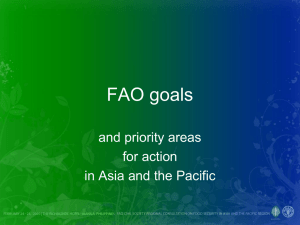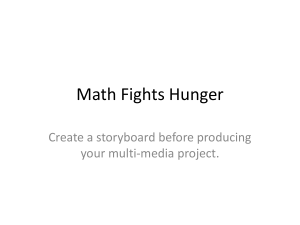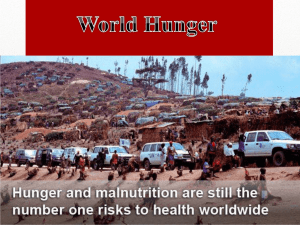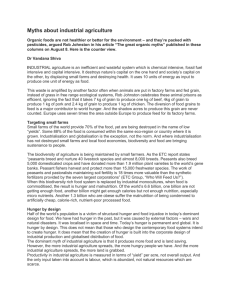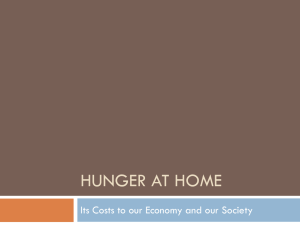Instruments for the Eradication of Hunger and Malnutrition
advertisement
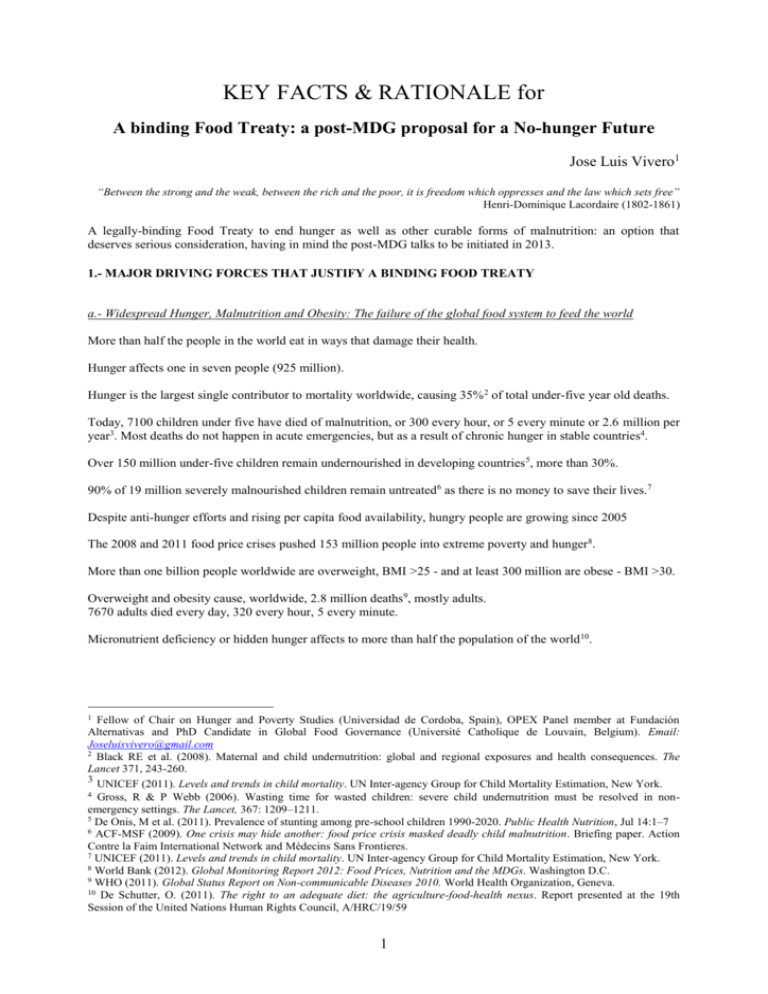
KEY FACTS & RATIONALE for A binding Food Treaty: a post-MDG proposal for a No-hunger Future Jose Luis Vivero1 “Between the strong and the weak, between the rich and the poor, it is freedom which oppresses and the law which sets free” Henri-Dominique Lacordaire (1802-1861) A legally-binding Food Treaty to end hunger as well as other curable forms of malnutrition: an option that deserves serious consideration, having in mind the post-MDG talks to be initiated in 2013. 1.- MAJOR DRIVING FORCES THAT JUSTIFY A BINDING FOOD TREATY a.- Widespread Hunger, Malnutrition and Obesity: The failure of the global food system to feed the world More than half the people in the world eat in ways that damage their health. Hunger affects one in seven people (925 million). Hunger is the largest single contributor to mortality worldwide, causing 35% 2 of total under-five year old deaths. Today, 7100 children under five have died of malnutrition, or 300 every hour, or 5 every minute or 2.6 million per year3. Most deaths do not happen in acute emergencies, but as a result of chronic hunger in stable countries4. Over 150 million under-five children remain undernourished in developing countries 5, more than 30%. 90% of 19 million severely malnourished children remain untreated6 as there is no money to save their lives. 7 Despite anti-hunger efforts and rising per capita food availability, hungry people are growing since 2005 The 2008 and 2011 food price crises pushed 153 million people into extreme poverty and hunger 8. More than one billion people worldwide are overweight, BMI >25 - and at least 300 million are obese - BMI >30. Overweight and obesity cause, worldwide, 2.8 million deaths 9, mostly adults. 7670 adults died every day, 320 every hour, 5 every minute. Micronutrient deficiency or hidden hunger affects to more than half the population of the world 10. 1 Fellow of Chair on Hunger and Poverty Studies (Universidad de Cordoba, Spain), OPEX Panel member at Fundación Alternativas and PhD Candidate in Global Food Governance (Université Catholique de Louvain, Belgium). Email: Joseluisvivero@gmail.com 2 Black RE et al. (2008). Maternal and child undernutrition: global and regional exposures and health consequences. The Lancet 371, 243-260. 3 UNICEF (2011). Levels and trends in child mortality. UN Inter-agency Group for Child Mortality Estimation, New York. 4 Gross, R & P Webb (2006). Wasting time for wasted children: severe child undernutrition must be resolved in nonemergency settings. The Lancet, 367: 1209–1211. 5 De Onis, M et al. (2011). Prevalence of stunting among pre-school children 1990-2020. Public Health Nutrition, Jul 14:1–7 6 ACF-MSF (2009). One crisis may hide another: food price crisis masked deadly child malnutrition. Briefing paper. Action Contre la Faim International Network and Médecins Sans Frontieres. 7 UNICEF (2011). Levels and trends in child mortality. UN Inter-agency Group for Child Mortality Estimation, New York. 8 World Bank (2012). Global Monitoring Report 2012: Food Prices, Nutrition and the MDGs. Washington D.C. 9 WHO (2011). Global Status Report on Non-communicable Diseases 2010. World Health Organization, Geneva. 10 De Schutter, O. (2011). The right to an adequate diet: the agriculture-food-health nexus. Report presented at the 19th Session of the United Nations Human Rights Council, A/HRC/19/59 1 b.-The Depletion Dilemma: The decadence of the fossil fuels that move the food system Global food system is highly dependent on oil and gas for production and trading, and consuming resources faster than are naturally replenished11. Oil and gas are not only sources of agro-chemicals, but enable mechanization of production, processing, transport and out-of-the season availability far away from the production areas. Oil peak will arguably be reached before 2020 12, unless oil reserves not yet accessible can be opened up for commercial purposes, and before 2050 oil will no longer be a commercial source of energy for the world. Declining of oil and gas stocks + growing with higher food demand = huge challenge, 70% increase in food production required to feed the 9 billion population by 2050 13 c.-The Threats of Climate Change to Food Production Climate change will contribute to food and water scarcity Rise of temperatures, diminishing rainfall and impact of extreme weather events having impacts in food production and food security mostly in rain-fed agriculture, three quarters of food producers14. By 2080, 600 million additional people could be at risk of hunger, as a direct result of climate change 15. Food production systems are a major source of greenhouse gas emissions. Future food supplies depends in part on how quickly a shift can be made to truly sustainable production systems and consumer behaviour. 2.- WHAT THE WORLD HAS DONE SO FAR: LITTLE AND UNSUCCESSFUL After the 2008 food crisis, flurry of international action: the UN High-level Task Force on the Global Food Security Crisis, the Global Partnership for Agriculture and Food Security, the reform of the Committee of Food Security, L´Aquila Initiative on Food Security and the Global Agriculture and Food Security Fund. Nowadays, the level of attention has diminished as food prices fell from the peak situation. Anti-hunger programmes remained seriously under-funded16 with Overseas Development Assistance (ODA) to agriculture falling from 17% to 4% in 20 years. Aid directed toward agriculture, food, and nutrition (only 10% of total commitments in 201017), has not increased in response to the food crises or the MDGs in 200018. ODA to nutrition in 2010 represents a negligible 0.3% of total aid flows despite widespread evidence that improving nutrition is key to meeting several MDGs and to enabling personal incomes to rise. 2009 L’Aquila G8 Summit: 13 countries pledged 22 billion USD to support of agriculture and food security initiatives in the next three years (6 billion USD new money). In mid-2012, 50% of the pledges19. 11 IAASTD (2009). Agriculture at a crossroads: the global report. Island Press. Sorrella, S et al. (2010). Global oil depletion: A review of evidence. Energy Policy, Vol. 38, Issue 9: Pages 5290-5295 13 FAO (2009). Global agriculture towards 2050. High-level Expert Forum on How to feed the World in 2050. Rome http://www.fao.org/fileadmin/templates/wsfs/docs/Issues_papers/HLEF2050_Global_Agriculture.pdf 14 Stern, N (2007). The Economics of Climate Change. The Stern Review. Cambridge University Press, Cambridge, UK. 15 UNDP (2007). Human Development Report. Fighting climate change. UNDP, New York, p. 90. 16 Macdonald, B (2008). Why have donors committed so few direct investments to eliminate child undernutrition? Id21 insights. Institute of Development Studies, University of Sussex. http://www.id21.org/insights/insights73/art07.html 17 OECD members disbursed 5.6billion USD to agriculture in developing countries whereas they spent 376 billion USD to support their own agriculture. Cascante, K. (2011). La escalada de precios de los alimentos: efectos y reacción ante una nueva crisis. Memo OPEX n°158, Fundación Alternativas. 18 World Bank (2012). Global Monitoring Report 2012: Food Prices, Nutrition and the MDGs. Washington D.C. 19 ONE (2011). Agriculture accountability. Holding Donors to their L’Aquila Promises. ONE Campaign, London. 12 2 3.- COHABITING WITH HUNGRY PEOPLE IS MORE EXPENSIVE THAN REMEDYING THEIR SITUATION. World Bank estimates that chronic malnutrition reduces the GDP of developing countries by 3%20. Adults who were malnourished as children earn at least 20% less than those who were not 21. The economic cost of having food-insecure people in the U.S. is 167.5 billion USD, above and beyond the 94 billion USD per year cost of government nutrition programs22. In Central American countries, the cost of hunger is over 6% of gross national income, whereas eradicating acute and chronic malnutrition wouldn´t take more 3% of GNI. The solutions are feasible and economically viable. 30 billion USD a year to enable 1 billion people to rise above the hunger threshold 23. The cost of eliminating severe acute malnutrition, the deadliest form, would be only 3.5 billion USD per year24. The cost to reduce drastically child chronic malnutrition in the 36 countries that harbour 90% of the stunted children and to prevent more than 1.1 million child deaths annually is only 11.6 billion USD a year 25. Is it much money? 1200 billion USD were used to bailed out the bankrupted private companies and banks 10% of money owned by the ten richest persons in the world would be enough to get rid of hunger 26. Ten people versus 1 billion is a rather sharp inequality. 4.- THE BUSINESS-AS-USUAL IN INTERNATIONAL NEGOTIATIONS IS TOOTHLESS Current inter-governmental bodies are unlikely to be successful in ensuring the level of commitment required a) Only a few governments are strongly motivated to address food security and nutrition issues. Most prefer to assume that the problems will disappear as a consequence of economic growth27. b) National delegates assume positions to the short-term interests of their domestic constituencies rather than ones which ensure the greatest good to mankind as a whole (the Tragedy of the Commons). c) The need to arrive at consensual agreements acceptable to ALL nations makes it virtually impossible to engage themselves in binding commitments. A Summit Declaration of Heads of States is a statement of good intent approved by general consensus. It is a the “least common denominator” agreement. d) Other governments only address hunger when they see political advantage in appeasing the demands of angry citizens or to attract international attention to a humanitarian crisis. Declarations of successive World Food Summits do not commit individual countries to any specific time-bound goals or actions for reducing hunger at a national level or for providing funds towards the costs of hunger eradication in other countries. However, a Treaty is a legal instrument, recognised under international law, which establishes binding obligations for all signatory states parties, including the obligation to reflect the terms of the agreement in national legislation. 20 World Bank (2006). Repositioning nutrition as central to development. A strategy for large-scale action. Washington, DC. Grantham-McGregor, S et al (2007). Development potential in the first 5 years for children in developing countries. The Lancet, 369:60–70 22 Shepard, DS et al. (2011). Hunger in America. Suffering We All Pay For. Center for American Progress. http://www.americanprogress.org/issues/2011/10/pdf/hunger_paper.pdf 23 Trueba, I & A MacMillan (2011). How to End Hunger in Times of Crises. Let´s start now. Universidad Politécnica Madrid Press. Madrid. 24 ACF-MSF (2009). One crisis may hide another: food price crisis masked deadly child malnutrition. Time to refocus at Madrid Food Summit. Briefing paper. Action Contre la Faim and Médecins Sans Frontieres. Paris. 25 Horton, S et al. (2010). Scaling Up Nutrition. What Will It Cost? The World Bank, Washington DC. 26 http://www.forbes.com/billionaires 27 Sumner, A et al. (2007). Greater DFID & EC Leadership on Chronic Malnutrition: Opportunities and Constraints. Institute of Development Studies, University of Sussex. 21 3 5.- CONCLUSIONS The world is doing badly with hunger reduction and halting the growth of the obesity epidemic. The prevailing food system must be reinvented as it has failed to fulfill its basic goals: feeding people in a sustainable manner and avoiding hunger. Little progress in hunger-related MDG indicators28. There is a huge gap between the promises that they make and the scale of their subsequent actions. The three legal regimes that regulate food security and agriculture at international level (human rights law, environmental law and trade law) work separately, with international trade law taking precedence over the other two to the detriment of small-scale farmers and the environment. Hunger is definitely high on the global agenda and a constant feature of every Presidential Summit29. Human-lives toll, implications for social unrest and economic losses related to hunger are well understood. Food production is increasingly threatened by climate change, globally stagnant crop yields, diminishing water, soil and agro-biodiversity resources, and the current energy and economic crises. Concerns over climate change and its consequences for food security, health and economic development may trigger for a re-conceptualization of our nation-state approach to global food problems (sharing sovereignty) Cost-effective and proven solutions exist. Unconventional and radical perspectives into the debate on possible solutions are needed We need a new instrument to push governments to deliver on the many commitments that they have made. The post-MDG Consensus can be that of the binding agreements to address global imbalances. 6.- PROPOSAL: A BINDING FOOD TREATY Develop a legally-binding Food Treaty to translate “soft” into “hard” (i.e. accountable) commitments by individual governments, raising the amount and predictability of financial support, either as a donor (in form of ODA) or as recipient country (in form of national budgets). The Food Treaty would aim to establish enforceable international law guaranteeing the right to be free from hunger and it should trigger the issuance of food security and nutrition laws. A preliminary draft of a possible Treaty has already being proposed in 201130 A framework for inter-country cooperation and mutual accountability at national and international level, defining the responsibilities of governments, UN agencies and civil society to undertake time-bound actions and to be held accountable for delivery and results. A Food Treaty would give hierarchical priority to human rights and environmental norms over obligations contained in trade and investment agreements, with a good example being the right to food. The Food Treaty would provide legal support to ongoing global food security and nutrition policies: SUN, UN REACH, ECHUI, ALCSH, and complement the Universal Declaration of Human Rights and the ICESCR. 28 World Bank (2012). Global Monitoring Report 2012: Food Prices, Nutrition and the MDGs. Washington D.C. G-8 (2001). Deauville Accountability Report. G-8 Commitments on Health and Food Security: State of delivery. Paris. 30 MacMillan, A & JL Vivero (2011). The governance of hunger. Innovative proposals to make the right to be free from hunger a reality. In: Martín-López, MA & JL Vivero, eds. New challenges to the Right to Food. CEHAP, Cordoba and Editorial Huygens, Barcelona. http://foodnutgov.ning.com/forum/topics/a-binding-food-treaty-where 29 4 7.- MAIN FEATURES OF A POSSIBLE FOOD TREATY a.- Focus on “eradication” rather than “halving” hunger, with WFS and MDG as intermediate objectives for 2015. The 2015 target has all the weaknesses of any half-measure: it fails to inspire a sense of urgency and unity and, even if achieved, it effectively condemns the “other half”. Good Example: Lula´s Zero Hunger Programme b.- The goal should be achieved no later than 2025. It is technically possible and financially affordable c.- Cover both hunger as well as other manifestations of malnutrition, including over-consumption, leading to overweight and obesity, that are contributing to premature death. d.- The treaty provisions shall act in the long-term global interest. e.- Self-imposition by willing governments of binding and monitorable long-term commitments. f.- Provisions whereby countries abide by decisions taken by the Conference of the Parties. g.- Link commitments of recipient and donor countries to assist in funding and technical cooperation services in a predictable manner 31. The Treaty would include an International Register of Commitments against Hunger. h.- Country as signatories of the Treaty but arrangements to include UN system, civil society organizations, the private sector, philanthropic foundations, academia and religious establishments. Small-scale and large-scale food producers and consumers shall be given an appropriate decision-making space. i.- Secretariat of the Treaty: CFS, UN agency, a consortium of UN agencies or any other suitable institution that may emerged from current debates. j.- A double accountability system, being operating at national and international level. The international mechanism could be based on a peer-review process similar to the Human Rights Council, OECD or NEPAAD. The national accountability system could be led by Ombdusman’s Office or any Human Rights institution. k.- Real-time systems for monitoring delivery on commitments and progress at national and global level. l.- Forum where countries could agree on food-related strategies to be adopted in international negotiations. m.- Bring the failure by any state party to honour its commitments to the attention of the Conference of the Parties (or the Claim and Redress Committee), and put in place procedures to remedy the situation. 31 Funds could be channelled directly to requesting countries or through a multilateral fund operated by an existing multilateral financing institution. 5 SUPPLEMENTARY ELEMENTS A.- Why should Governments support a Food Treaty? 1.- The huge perils of inaction about food issues are now evident to all governments 2.- Reduced migration towards developed countries and mitigation of terrorism and national civil unrest32. 3.- Getting rid of hunger is a worthy investment. 4.- The evident failure of business-as-usual approaches to hunger reduction. 5.- Well designed national programmes anchored in appropriate legal and institutional frameworks can work - i.e. Brazil, Thailand, Ghana and Peru this decade, and Europe and Japan after the second World War. 6.- Benefits of shifting from “soft” to “hard” reciprocal commitments to achieve major global objectives, for instance the Durban Platform for Enhanced Action on Climate Change and the Arms Trade Treaty. Non-binding agreements have been toothless in moving global challenging issues in the positive direction. 7.- Growing public consciousness of human rights and especially of the fundamental right to be free from hunger, strongly associated to the right to life. B.- Lessons learned from other legally-binding international agreements (a) The International Treaty on Plant Genetic Resources for Food and Agriculture (ITPGRFA). (b) Food Aid Convention-Food Assistance Convention. (c) The ICESCR and the Optional Protocol. In addition to them, other binding Treaties that serve as instruments within which genuinely interested nations work jointly towards the attainment of agreed global goals can be found below33. Some lessons from those experiences: a.- The process itself raises the level of public knowledge of the issues being addressed. b.- A relatively small number of governments may sign up to a convention at early stage, but once ratified by the required number, more nations progressively become signatories. c.- As the governance of each convention is provided only by signatories, the actions for which commitments are made are on a higher plane than if they were defined through negotiations involving all governments. C.- An accompanying civil society Global Campaign should be needed Organise an International Campaign led by NGOs/CSOs to demand anti-hunger actions by governments, and request them to formally to negotiate and subsequently sign the Food Treaty. The campaign would raise public awareness and understanding on hunger and its solutions and it should be based on existing movements/campaigns, networks and initiatives. D.- Preventing hunger-related deaths is a moral imperative Moral victory for Social Justice. Credibility to globalization. Release latent human energy and creativity. The fight against hunger must recall the Fraternity between human beings, a concept from French Revolution with Liberty and Equality34 (political and philosophical foundations of neoliberal economy and democratic societies). Solidarity between states, civic friendship, cosmopolitanism and reciprocity that are so much needed in those times of growing self-interest, isolationism and private rights. 32 Holt-Giménez, E & R Patel (2009). Food Rebellions: Crisis and the Hunger for Justice. Fahumu Books, UK Examples: the Geneva Convention on the Treatment of Prisoners of War, the Ottawa Convention on the prohibition of antipersonnel mines and the Rio Convention on Biological Diversity and its additional protocols, such as the Montreal Protocol on substances that deplete the ozone layer and the Cartagena Protocol on Biosafety. 34 Rawls, J (1999) A theory of justice. Harvard University Press. 33 6

